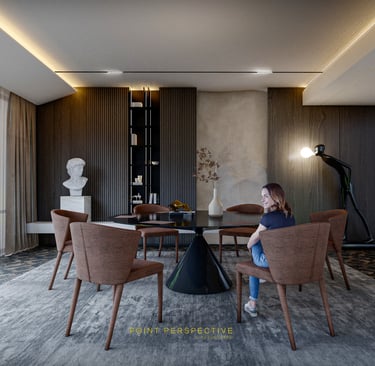3D Rendering from Point Perspective Studio: Bringing Your Designs to Life
Within the dynamic realm of digital art, 3D rendering has emerged as a fundamental component of visual narratives. The use of point perspective is one crucial element that gives these representations life. This post will walk you through the nuances of 3D rendering in a point-perspective studio, offering insightful analysis and useful advice for novice and experienced artists alike.
Talha Rehman
10/20/20235 min read


Definition of 3D rendering
The technique of creating a two-dimensional image from a three-dimensional model is known as three-dimensional rendering. It is an essential stage in the visualization of designs, ranging from building plans to product prototypes.
Importance of point perspective in rendering
By simulating how the human eye sees space, point perspective gives 3D graphics more depth and realism. This method is quite effective in enhancing the rendering's visual impact.
Understanding Point Perspective
Basics of point perspective
Point perspective uses a single point (vanishing point) on the horizon to give the impression of depth. This method gives the depiction a sense of scale and directs the viewer's gaze.
Applications in 3D rendering
Point perspective is used in many fields, such as product design, gaming, and architecture. It's an adaptable tool that improves how visual representations deliver stories.
Enhancing depth and realism
Artists can generate a greater sense of realism and depth in their representations by carefully positioning things in relation to the vanishing point.
Setting Up a Studio for 3D Rendering
Choosing the right space
Choosing the right studio space is essential for the best rendering circumstances. Think about things like general comfort, ventilation, and lighting.
Lighting considerations
To bring out the details in your 3D renderings, you need to use the right lighting. Try out various lighting configurations to determine the ideal harmony.
Essential equipment
Purchasing top-notch hardware, such as a graphics card, rendering software, and powerful computer, is necessary for a seamless workflow and stunning outcomes.
Best Practices for 3D Rendering from Point Perspective
Camera placement and angles
Try a variety of camera angles to see which ones are the most visually appealing and energetic. Don't be scared to think creatively and outside the box.
Utilizing focal points
Decide the important details in your scenario you want to draw attention to. You may direct the viewer's attention and produce a more captivating visual experience by employing focal points.
Creating dynamic compositions
Examine artistic compositions that have energy and movement in them. Audiences are drawn in and made to remember moments that are dynamic.
Software and Tools
Overview of popular rendering software
Examine the characteristics of well-known rendering programs including KeyShot, V-Ray, and Blender. Every instrument has advantages and disadvantages, so pick the one that best suits your requirements.
Plugins for point perspective rendering
Investigate plugins made expressly for improving point perspective in 3D renderings to get the most out of your selected program.
Real-world Examples
Showcasing successful projects
Analyze case studies of accomplishments in 3D rendering that make good use of point perspective. Take notes on practical examples to guide and inspire your own work.
Analyzing effective use of point perspective
Dissect the components that distinguish particular depictions. Examining effective cases aids in your comprehension of the subtleties involved in using point perspective.
Overcoming Challenges
Common issues in 3D rendering
Talk about common issues including texture mapping, hardware constraints, and rendering times. Solve problems efficiently to guarantee a productive workflow.
Troubleshooting point perspective problems
Learn how to handle any point perspective-specific problems you may run into. Recognize typical errors and how to avoid them for best outcomes.
Advancements in 3D Rendering Technology
Emerging trends
Keep up with the most recent developments in 3D rendering technology. See what lies ahead for the sector, from AI-powered improvements to real-time rendering.
Future possibilities
Examine how the field of 3D rendering is changing and consider what might be possible in the future. The opportunities available to designers and artists are always changing due to technological breakthroughs.
Benefits of Incorporating Point Perspective in 3D Rendering
Enhanced visual appeal
Find out how renderings using point perspective have a more appealing overall appearance. Use this method to produce photographs that are intriguing and eye-catching.
Improved client satisfaction
Point perspective gives renderings more depth and realism, which is something that clients frequently value. Gain more client pleasure by being proficient in this important skill.
Increased market competitiveness
Gaining mastery over point perspective helps you stand out from the competition in a competitive market. It gives your work a distinctive edge and draws in customers looking for cutting-edge graphic solutions.
Case Studies
Examining industry-specific applications
Examine the various ways that various businesses use point perspective in their 3D illustrations. See how this concept may be applied in a variety of fields, including gaming and architecture.
Success stories from various sectors
Read about the achievements of artists and rendering studios who have mastered the strategic use of point perspective in 3D rendering. Take note of their accomplishments and experiences.
Tips for Beginners
Entry-level advice for aspiring 3D artists
Get helpful tips on getting started if you're new to 3D rendering. Acquire the essential knowledge and progressively integrate point view into your work process.
Learning resources and communities
Find communities and resources online where aspiring 3D artists may improve their abilities. Make connections with other artists, exchange stories, and gain knowledge from one another.
Industry Insights
Expert opinions on the importance of point perspective
Learn why point perspective is a useful ability in the field of 3D rendering from professionals in the field. Recognize how it affects artistic expression and visual narrative.
Interviews with seasoned 3D rendering professionals
Examine interviews with experts who have left their imprint on the 3D rendering business. Find out about their experiences, difficulties, and how point perspective is used in their work.
The Intersection of Art and Technology
How point perspective adds an artistic touch
Examine the aesthetic aspects of 3D rendering and the role that point perspective plays in the final product. Achieve a balance between artistic expression and technical accuracy.
Balancing creativity and technicality
Recognize the fine line that separates technical expertise from creativity. Learn how artists use 3D rendering to traverse the nexus between art and technology.
Environmental Considerations
Sustainable practices in 3D rendering studios
Examine sustainable methods and the effects that 3D rendering has on the environment. Find out how studios may implement environmentally responsible practices without sacrificing quality.
Eco-friendly rendering solutions
Learn about methods and resources that support environmentally friendly rendering. Investigate choices that are in line with ecologically responsible methods as the industry changes.
Conclusion
Recap of key points
Write a summary of the article's main conclusions, highlighting the value of point perspective in 3D rendering facilities.
Encouragement for readers to explore point perspective
Urge readers to use point perspective in their own creative endeavors. Stress how it completely changes the way 3D renderings look.
FAQs
Q: Is point perspective suitable for all types of 3D renderings?
Point perspective can improve the visual attractiveness of different representations, but whether it is appropriate for your project will depend on its particular objectives.
Q: Q: Are there specific software recommendations for beginners interested in 3D rendering?
Beginners can begin with easier-to-use programs like SketchUp or Blender before moving on to more sophisticated ones.
Q: How can I troubleshoot common issues in 3D rendering?
Take care of problems like hardware constraints or rendering times by keeping up with program upgrades, optimizing your scene, and making necessary adjustments.
Q: What role does lighting play in 3D rendering from a point perspective?
For your renderings to have depth and detail, lighting is essential. Try a variety of lighting configurations to get the desired result.
Q: Are there online communities for 3D artists to connect and learn from each other?
Yes, a plethora of online networks and forums offer a venue for knowledge sharing, advice seeking, and collaboration among 3D artists.Are there specific software recommendations for beginners interested in 3D rendering?
Beginners can begin with easier-to-use programs like SketchUp or Blender before moving on to more sophisticated ones.
Q: How can I troubleshoot common issues in 3D rendering?
Take care of problems like hardware constraints or rendering times by keeping up with program upgrades, optimizing your scene, and making necessary adjustments.
Q: What role does lighting play in 3D rendering from a point perspective?
For your renderings to have depth and detail, lighting is essential. Try a variety of lighting configurations to get the desired result.
Q: Are there online communities for 3D artists to connect and learn from each other?
Yes, a plethora of online networks and forums offer a venue for knowledge sharing, advice seeking, and collaboration among 3D artists.

